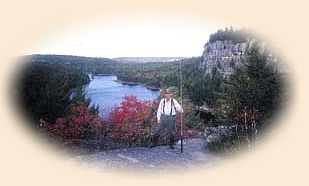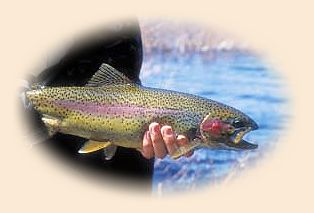 Ask anybody where the Penokean Hills are and, if he or she is bold enough to
guess, the likely response will probably be "southern Alberta, I think". Tell that
same person that these hills hold some of the best multi-species trout waters
around, and the blank expressions will get blanker! Mention that the area resides
amongst northern Ontario's greatest concentration of natural trout lakes and you'll
probably be able to hear a pin drop. Only a handful of fishermen, and even fewer
fly fishers, know about the outstanding angling that is available in this part of Ontario.
Stop by any tackle store or gas station from Elliot Lake to Iron Bridge and you
are liable to see photos of some of the angling success stories for which this area
has justly become famous.
Ask anybody where the Penokean Hills are and, if he or she is bold enough to
guess, the likely response will probably be "southern Alberta, I think". Tell that
same person that these hills hold some of the best multi-species trout waters
around, and the blank expressions will get blanker! Mention that the area resides
amongst northern Ontario's greatest concentration of natural trout lakes and you'll
probably be able to hear a pin drop. Only a handful of fishermen, and even fewer
fly fishers, know about the outstanding angling that is available in this part of Ontario.
Stop by any tackle store or gas station from Elliot Lake to Iron Bridge and you
are liable to see photos of some of the angling success stories for which this area
has justly become famous.
For me, the Penokean Hills, and more broadly, Ontario's North Shore Region
(from Espanola to Sault Ste. Marie) have always held a certain fascination. From
the times I first saw some of those gas station photos of six-pound plus brook
trout, I wanted to find the glory holes where I could catch them. It's not only the
fishing, however, which is spectacular in Penokean Hills Country–the landscape
is rugged, ever-changing and the lakes are mainly spring-fed and crystal
clear–often with a greenish cast that is reminiscent of the trout waters out West.
 Trout were introduced to the Blue Lake area in 1944 by Vic Rutledge, who was
one of the first to realise the recreational potential there. Carrying several dozen
rainbow trout fingerlings in milk cans along the 27 kilometre Blue Lake Trail and
stopping every hour at freshets to replenish the water supply, Rutledge managed
to get the fish in and release them into Blue Lake. By the end of that decade,
they'd moved upstream from Blue Lake into Robb, Townline, Elbow and Whitebear
Lakes, and downstream into Dougall and Endikai Lakes. Lake trout and brook
trout were stocked later, and all three species established naturalised populations
throughout the area. There has been no stocking of the major naturalised waters
since the late 1950s.
Trout were introduced to the Blue Lake area in 1944 by Vic Rutledge, who was
one of the first to realise the recreational potential there. Carrying several dozen
rainbow trout fingerlings in milk cans along the 27 kilometre Blue Lake Trail and
stopping every hour at freshets to replenish the water supply, Rutledge managed
to get the fish in and release them into Blue Lake. By the end of that decade,
they'd moved upstream from Blue Lake into Robb, Townline, Elbow and Whitebear
Lakes, and downstream into Dougall and Endikai Lakes. Lake trout and brook
trout were stocked later, and all three species established naturalised populations
throughout the area. There has been no stocking of the major naturalised waters
since the late 1950s.
Today, the mix of lake trout, rainbow trout and brook trout has been recognized
as the province's only self-sustaining inland three-species trout system. In 1997, I
fished one of the main lakes with three visiting American fly fishermen. One of
them, during a 20 minute span along a scree slope below a 400-foot cliff face
caught a 20 inch rainbow, a 14 inch brookie, and 20 inch lake trout on the
same fly! He was ecstatic.

While almost every small pond and lake in this region holds trout, there are some
locations where the bounty is more plentiful. One such area is that surrounding
Kirkpatrick Lake–locally referred to as Blue Lake. The watershed encompassing
Blue Lake (holding over 100 lakes and as many small streams) is one of the most
interesting trout systems in Ontario, if not all of Canada. This is because it harbours
three self-reproducing trout species within several of the bigger stillwaters and yet
also provides exceptional opportunities for big brookies in the smaller ponds. Six
large lakes, all connected to the West Little White River, contain brook trout, lake
trout and rainbow trout. What is even more amazing is that these fish are naturalized.
They were planted here in the mid-1940s and 50s and have never been re-supplied
since. As such, each species has developed into a unique strain that are often unlike
any others seen elsewhere in Ontario. The rainbows are loaded with black spots
over their entire bodies–similar to those of Alaska. They are robust fish, with
tremendous splashes of burgundy, hot pink and olive-green. The lakers are also
heavily spotted and a dusky bronze, sometimes fading to bluish-grey.
|
The Blue Lake area, due to the trout preserve policies in place, is only
accessible by canoe, hike-in or fly-in means. It is a roadless area, off-limits
to highway vehicles. The closest highway is 546 from Iron Bridge to Elliot
Lake. A canoe trip in to Blue Lake from the highway takes one day, hiking
can take up to two days.
There are three outfitters who operate camps or outposts in the area. One
in particular, the Blue Fox Camp, actively encourages fly fishers and promotes
fly fishing because it appreciates fly fishing's conservation ethic, especially
catch-and-release.
Contact:
Dr. Paul Morgan
- Blue Fox Camp
8178 Yonge Street
Thornhill, Ontario
L4J 1W5
Telephone: (905) 886 - 8242 - All season
(705) 461 - 6159 - Summer |
Although there is some good river fishing, the fishing in Blue Lake country is primarily
on stillwaters, from ponds to large lakes.
Stillwaters: forage and flies
The major food items in the Blue Lake watershed are crayfish, leeches, dragonflies,
damselflies, scuds, mayflies, midges, caddis flies, and baitfish. The leeches, which
trout feed on year-round, are usually black, or dark brown, and range in size from
two to four inches. A marabou or rabbit strip pattern provides an excellent imitation.
They're effective for lake trout fished deep during the summer migration to colder
water. Blue Lake dragonfly nymphs are dark olive green with thick abdomens and
typically measure about two inches long, while the damsels are olive green, slender,
and about one to one and a half inches long. The scuds are either dark green or
cream and about half an inch long. Unlike scuds, dragons and damsels can be
fished higher in the water column, but all three are best used closer to the bottom,
especially around beaver lodges, deadfalls, and weeds. Patterns tied with some
sparkle in the dubbing and picked out to look "buggy" work the best.
Mayflies come in most of the familiar hatches of the south, but the most important is
the large Hexagenia (Brown Drake) hatch, which usually occurs in mid-June. Dry flies
with a natural deer-hair tan body are excellent impressions of these flies.
Midges are also an important trout food on these stillwaters. During mid-summer,
rainbows, particularly, will feed selectively on adults on the surface and in the film.
Any small buzzers, midge emergers work well, while weighted midge patterns are
effective fished from the bottom up.

Caddisflies tend to be more important on the rivers and in the back lakes (where
it's mostly brook trout). Rhyacophillidae and Limnophillidae are the most important,
and are most effectively imitated with wet flies and emergers with bright green or
yellow-green abdomens and brown thoraxes, particularly with sparkly dubbing
and picked out fibres to create a "halo".
The most common baitfish are northern redbelly dace and common shiners.
Pearl Mylar zonkers and various silver bodied streamers are effective
imitations. ~ Geoff Bernardo
Continued next time!
|


 Ask anybody where the Penokean Hills are and, if he or she is bold enough to
guess, the likely response will probably be "southern Alberta, I think". Tell that
same person that these hills hold some of the best multi-species trout waters
around, and the blank expressions will get blanker! Mention that the area resides
amongst northern Ontario's greatest concentration of natural trout lakes and you'll
probably be able to hear a pin drop. Only a handful of fishermen, and even fewer
fly fishers, know about the outstanding angling that is available in this part of Ontario.
Stop by any tackle store or gas station from Elliot Lake to Iron Bridge and you
are liable to see photos of some of the angling success stories for which this area
has justly become famous.
Ask anybody where the Penokean Hills are and, if he or she is bold enough to
guess, the likely response will probably be "southern Alberta, I think". Tell that
same person that these hills hold some of the best multi-species trout waters
around, and the blank expressions will get blanker! Mention that the area resides
amongst northern Ontario's greatest concentration of natural trout lakes and you'll
probably be able to hear a pin drop. Only a handful of fishermen, and even fewer
fly fishers, know about the outstanding angling that is available in this part of Ontario.
Stop by any tackle store or gas station from Elliot Lake to Iron Bridge and you
are liable to see photos of some of the angling success stories for which this area
has justly become famous. Trout were introduced to the Blue Lake area in 1944 by Vic Rutledge, who was
one of the first to realise the recreational potential there. Carrying several dozen
rainbow trout fingerlings in milk cans along the 27 kilometre Blue Lake Trail and
stopping every hour at freshets to replenish the water supply, Rutledge managed
to get the fish in and release them into Blue Lake. By the end of that decade,
they'd moved upstream from Blue Lake into Robb, Townline, Elbow and Whitebear
Lakes, and downstream into Dougall and Endikai Lakes. Lake trout and brook
trout were stocked later, and all three species established naturalised populations
throughout the area. There has been no stocking of the major naturalised waters
since the late 1950s.
Trout were introduced to the Blue Lake area in 1944 by Vic Rutledge, who was
one of the first to realise the recreational potential there. Carrying several dozen
rainbow trout fingerlings in milk cans along the 27 kilometre Blue Lake Trail and
stopping every hour at freshets to replenish the water supply, Rutledge managed
to get the fish in and release them into Blue Lake. By the end of that decade,
they'd moved upstream from Blue Lake into Robb, Townline, Elbow and Whitebear
Lakes, and downstream into Dougall and Endikai Lakes. Lake trout and brook
trout were stocked later, and all three species established naturalised populations
throughout the area. There has been no stocking of the major naturalised waters
since the late 1950s.
